In this good practice note, N. Akila, M. Jothilakshmi, K. Senthilkumar, K. Satheeskumar, R. Prabaharan and K. Jayakumar discuss the interventions implemented in livestock production under NICRA scheme at Vadavathur & Jambumadai village of Namakkal, Tamil Nadu and present its impact in production, productivity and sustainable livelihood of farmers.
CONTEXT
Recurring drought is a major challenge experienced by farmers of Namakkal district in Tamil Nadu. To address the intertwined problems of farmers in drought prone areas, since 2011, Indian Council of Agricultural Research- Central Research Institute for Dryland Agricultural Research (ICAR-CRIDA), Hyderabad, has implemented National Innovations on Climate Resilient Agriculture (NICRA) scheme through Krishi Vigyan Kendra (KVK), Namakkal, at Vadavathur Panchayat, Tamil Nadu. The main objective of the scheme was to promote climate resilient agriculture and sustain livelihoods of farmers through technical demonstrations. Relevant interventions are covered under four modules viz., natural resources, crop production, livestock and fisheries and institutional interventions. Since livestock can be affected by drought through heat stress, high morbidity, low productivity etc., the good practices implemented by KVK Namakkal under livestock module provide an insight into the type of interventions that can be implemented to help farmers cope with climate stresses.
GOOD PRACTICES
Village selection:
Based on documented records available from Agro Climate Research Centre, Tamil Nadu Agricultural University (TNAU), a village panchayat frequently prone to drought and dry spells (in the ten years between 2000-2010) was selected.
| Historical trends in rainfall | Average year | |||
| 1990-2000 | 2000-2010 | |||
| No. of rainy days | 37.0 | 33.7 | ||
| No. of dry spells during kharif season | >10days | 7 | 6 | |
| >15days | 7 | 3 | ||
| >20days | 16 | 22 | ||
| >40days | 7 | 7 | ||
| No. of intensive rain | >60mm/day | 4 | 1 | |
Vadavathur village panchayat, comprising Vadavathur and Jambumadai villages, receive an average rainfall ranging from 338 mm to 957 mm. The mean annual rainfall is 400 mm. The villages experienced frequent drought and several dry spells with mean maximum temperature of 46°C in the last six years. The most important crops here are onion, sorghum and groundnut. These villages were selected to implement NICRA project through KVK Namakkal since 2011.
Benchmark survey:
A benchmark survey was conducted with pretested interview schedule in the selected village panchayat in 2011 to understand the demographic, socioeconomic status of farmers and their farming system. From the survey results, it was found that majority of the farmers were marginal farmers, and livestock and poultry were reared by them mainly to meet their household needs. They reared crossbred Jersey, Holstein Friesian and nondescript dairy cattle, non-descript goat and native chicken. The village had 370 cattle, 405 small ruminants and 839 desi poultry in 2011. The predominant cropping season is October to January. Sorghum in kharif and onion in rabi were the chief crops that covered more than 400 ha in the village. The crop residues of onion and sorghum were the main source of feed for livestock.
Formation of Village Climate Risk Management Committee (VCRMC):
Since technology demonstration under NICRA was to promote sustainable climate resilient agricultural interventions to overcome climate vulnerabilities like drought, all farmers in the selected village were beneficiaries of the scheme. A Village Climate Risk Management Committee (VCRMC) was formed with 18 progressive farmers after conducting regular meetings in the village. The VCRMC members conducted monthly meetings to discuss persisting problems in agriculture and allied farming activities, and presented minutes of the meetings to the KVK. Based on farmers’ inputs, suitable interventions were selected and beneficiary farmers identified considering the cropping pattern and livestock reared by the VCRMC members every year to implement interventions in the field. More than 80 per cent of the farmers received at least one of the benefits under the four NICRA modules over a period (2011-2020).
Interventions for livestock production and management:
Construction of improved sheds for reducing heat stress in livestock
The importance of shed management was imparted to farmers through training programmes. Model sheds were established in the village by encouraging farmers to share the cost of shed construction. The selection of farmers for shed construction was made based on the stock size, willingness to construct under cost sharing and allowing other farmers to see the shed. Those who reared atleast five dairy animals, 20 sheep and goats and 15-20 desi chickens were selected. The farmers were advised to plant trees near the sheds and place damp gunny bags over the roof and sides during hot days to protect animals from direct sunlight and alleviate heat stress.
Dairy cattle sheds:
Based on scientific housing management practices, cattle sheds were constructed with optimum space per animal, cross ventilation, east-west orientation, thatched roof and foggers in Asbestos Cement sheet roofing. Planting trees around the sheds was advocated. One dairy shed was constructed under the scheme and the farmers were encouraged to build sheds with scientific orientation. The foggers were provided under 50 per cent cost sharing arrangement. The cost of the foggers was a total of Rs. 12,000 for a shed that could accommodate ten animals and the farmers share was Rs.6,000.
Sheep and goat sheds (Small ruminant sheds):
With optimum space per animal, orientation, cross ventilation and trees around the sheds either slatted floor sheds or ordinary sheds which accommodate 15-20 animals were introduced in farmers’ fields for small ruminant. Farmers contributed 50 per cent and rest came from the NICRA scheme budget. The average cost of a shed of 120 square feet was Rs. 25,000.
Shelters for desi poultry:
Cages of the size 8’x4’, 6’x4’ and 9’x4’ were introduced to keep 20-30 birds comfortably. These cages were designed to protect birds from predators, heat stress during hot summer and to provide night shelter. The cages costed between Rs.9,000 and Rs.12,000 from 2016 to 2020. The farmers paid 50 per cent of the cost. The cost sharing pattern was started from 2016 among farmers mainly to a avoid rush to avail benefits. Also, it helped to identify the real beneficiary and increase the number of beneficiary farmers. When farmers shared the cost, it increased the responsibility to take care of farming in a profitable way. In the adopted village, a total of 23 small ruminant sheds, 51 poultry cages and foggers for five cattle sheds were established with 50 per cent cost sharing between farmers and the project (Table 1).
Table 1. Sheds constructed to provide shelter for livestock/ poultry
| Interventions | Number of farmers involved | ||||||||
| 2011-2012 | 2012-2013 | 2013-2014 | 2014-2015 | 2015-2016 | 2016-2017 | 2017-2018 | 2018-2019 | 2019-2020 | |
| Foggers for cow shed | – | – | – | 1 | – | – | – | – | 4 |
| Poultry shelters | – | – | – | 11 | 11 | 10 | 14 | – | 5 |
| – | – | – | 1 | – | – | – | – | ||
| Sheep shed | – | 1 | – | 2 | – | 5 | 9 | – | – |
| Goat shed (Slatted floor) | – | – | – | – | – | 6 | – | – | – |
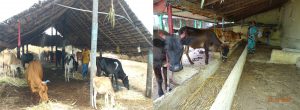 Dairy sheds
Dairy sheds
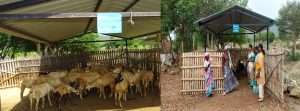
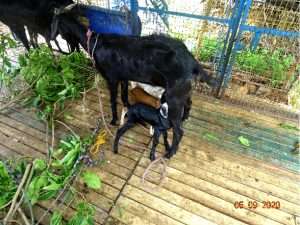 Sheep and goat sheds
Sheep and goat sheds
 Desi poultry cages
Desi poultry cages
Interventions in Scientific Feeding Management
The KVK identified field gaps like lack of practice of balanced feeding, lack of awareness of micro-nutrient feeding (mineral block and mineral mixture), low nutrition resulting in high incidence of infertility and low animal production due to maintenance of animals on grazing in private lands. The gaps were reduced with implementation of interventions like demonstration of low cost concentrate feed preparation, feeding of mineral mixture and mineral block, green fodder production and silage making in the field. Frequent training programmes and demonstrations assisted farmers in gaining knowledge in scientific feeding of livestock. These practices improved nutritional status of the animals. Almost all the dairy farmers and handful of small ruminant farmers in the village adopted feeding livestock mineral mixture and mineral block. The technology is sustained among farmers till date with provision of mineral mixture under free/subsidized rate from state animal husbandry department and Aavin (Tamil Nadu Milk Producers Cooperative Federation) to combat drought. This is seen in the improved health status of animal.
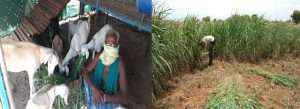 Green fodder cultivation and feeding to livestock
Green fodder cultivation and feeding to livestock
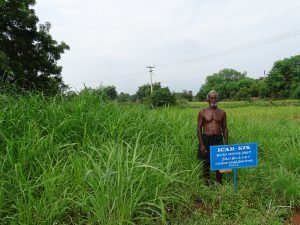 Concentrate feed preparation and mineral mixture feeding
Concentrate feed preparation and mineral mixture feeding
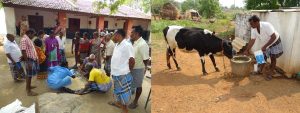 Silage making with green fodder and onion crop residues
Silage making with green fodder and onion crop residues
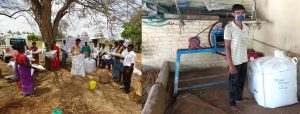 Silage preparation /Farmer making silage
Silage preparation /Farmer making silage
Disease prevention measures
The animals, especially the small ruminants, suffer parasitic infestations and farmers had very low knowledge about parasitic control measures. Some farmers were found adopting improper deworming practices. As a result, about 55 per cent of the sheep and goat had parasitic infestation, 20 per cent had anaemia and alopecia while 40 per cent of animals had low weight gain. Similarly, the farmers had poor knowledge of disease control measures in goats, Blue tongue (BT) in sheep and Ranikhet in poultry. About 95 per cent of the farmers were not aware of the vaccination schedule to be followed to control diseases in animals. Although, the cattle owners were aware of the Foot and Mouth Disease (FMD) vaccine, they did not follow proper vaccination schedule resulting in loss of production and expenditure on treatment of FMD affected animals.
Animal health camps for deworming and vaccination were conducted regularly once in three months which helped minimise disease occurrence in livestock in the adopted village(table 2). The Animal Science faculty working in KVK along with the scheme’s Senior Research Fellow and Junior Research Fellow conducted the camps. The paravets of Aavin and the field veterinarian from the village dispensary are contacted for FMD vaccination. The following disease preventive measures were undertaken to save the livestock.
- Deworming of young ones and needy animals and birds
- Preventive Vaccinations in animals-Foot and Mouth (FMD) in cattle,Peste Des Petits Ruminants (PPR) commonly known as sheep and goat plague in small rumiants, Blue tongue (BT) in sheep and Ranikhet disease vaccine K (RDVK) in desi poultry
- Treatment of sick animals
Table 2. Number of animals vaccinated and dewormed in NICRA village
|
Interventions |
2011-2012 | 2012-2013 | 2013- 2014 | 2014-2015 | 2015-2016 | 2016-2017 | 2017-2018 | 2018-2019 | 2019-2020 |
| Goat (PPR) and
Deworming |
50 | 250 | 130 | 588 | 260 | 605 | 300 | 250 | |
| Sheep (EnteroToxemia)
and Deworming |
60 | 325 | 200 | 845 | 320 | – | 400 | 415 | 400 |
| Cow (FMD) and Deworming | 50 | 125 | 54 | 632 | 107 | 825 | 914 | 920 | |
| Desi chicken
(LaSota Vaccine) |
100 | 350 | 320 | 213 | 213 | 400 | 1110 | 415 | |
| Chicken (Ranikhet Disease Vaccine K) | 100 | 1850 | 836 | 632 | 632 | 483 | 1060 | 810 | 967 |
| Anti-worm medication (Albendazole) | 1840 | 1156 | 756 | 845 | – | 1200 | 980 | 1110 | |
| Blue tongue vaccination | – | – | – | – | – | 150 | 820 | 315 | 340 |
The farmers now regularly follow vaccination and deworming of their animals which helped prevent disease outbreak, decrease treatment cost and increase their incomes.
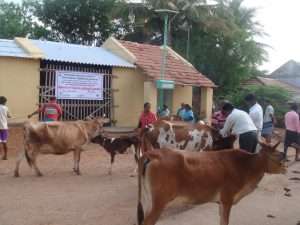 FMD vaccination
FMD vaccination
 Sheep vaccinated against Blue Tongue / Desi chicken vaccinated against ranikhet
Sheep vaccinated against Blue Tongue / Desi chicken vaccinated against ranikhet
CHALLENGES
We faced a number of challenges while implementing this programme. These were:
Farmers’ unwillingness to contribute: Farmers’ contribution to establish sheds was initiated in 2016 to increase farmer coverage under the intervention. That time, no farmer was interested to pay for sheds. After a series of meetings and by seeing advantages of sheds and performance of animals, voluntary participation of farmers increased from the next year, with 50 per cent contribution.
Lack of interest in livestock vaccination at a common place: When the scheme started, the farmers were not keen to vaccinate their animals by assembling at a common place. They also reported the animals became sick after vaccination. To overcome this, door to door vaccination was initiated. Later, when the farmers could understand the improvement in health status of animals and witnessed low mortality rate, they started cooperating for vaccination at a common place. Now, even if camps are not arranged through the scheme, they bring their livestock to veterinary dispensary or a para veterinarian, to get vaccination whether free or paid.
Lack of knowledge in green fodder production: Though green fodder seeds were supplied through the scheme free of cost, most farmers did not cultivate them and wasted the seed. Later, by seeing the yield of perennial green fodder sorghum CoFS-29 and the production performance of dairy animals, the practise was taken up. Presently, 56 ha in the two villages is observed to be under green fodder cultivation.
Conflicts among farmers: Conflicts and sour relations among farmers initially hindered propagation of the technical interventions in the village. Later, through the VCRMC the farmers were convinced and dissemination took place on a larger scale.
Status of livestock farming before NICRA
|
IMPACT
Impacts of this initiative can be categorised into impact on livestock production, sustainable livelihood of farmers as well as social impact. Some of these are:
1.Impact on Livestock Production
- Adoption of improved shelter practices helped the animals better dissipate heat, increased their living comfort, increased the feed conversion ratio and sustained production.
- Feeding of mineral mixture at 30-40 g/animal/day along with paddy straw which resulted in increased milk yield 200-300 ml/day and fat content enhanced to 4.0% and SNF to 7.5%. Ultimately, revenue through sale of milk increased from Rs. 3 to Rs. 5/l. The physical health and body weight of the calves also improved.
- Mineral block feeding to small ruminants helped increase weight gain of animal (by 6-9%) and improved reproductive performance of animal (kidding/lambing interval reduced) and mortality reduced in young ones.
- Improved body weight of small ruminants (6-9%) and reduced kidding/lambing interval.
- The mortality in calves, lambs and kids was reduced to 1-3 per cent due to regular healthcare service, less morbidity due to reduced internal parasites and incidence of disease outbreaks. The average monthly weight gain was improved to 15-20 kg in calves and 2.8 kg in lambs and kids.
- The daily average milk production increased to 4000 l in the village with animal productivity of 6.15 l.
- Incidence of silent heat was reduced from 20% to 10%. Conception rate was improved. Number of artificial inseminations/conception was reduced from 3-4 inseminations to 1-2 insemination and onset of postpartum oestrous reduced from 90 days to 60-65 days. Body weight of 1.2 kg was obtained at 5 months of age in desi poultry and the clutch size increased from 10 to 15 eggs. The chick and adult mortality was reduced from 3% to 2% and from 20% to 10% respectively.
2.Impact on Sustainable Livelihood of Farmers
- Sustained income from livestock and desi chicken which helped farmers bear the risks of crop loss.
- 43 per cent of farmers adopted the intervention. Continued adoption of livestock production as income generating activity by NICRA farmers.
- All these interventions helped farmers achieve one calf per year. The livestock population increased three-four fold between 2011 and 2019. The revenue increased through sale of milk from Rs. 3 to Rs. 5/l.
- In small ruminants, almost 44 per cent of the farmers in the village rear 3,285 sheep and goats with an average flock size of 15 animals. They are getting a regular income.
- 53 per cent of farmers of that village are now rearing 2581 desi poultry with a flock size ranging between 10 and 100 birds.
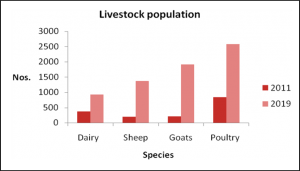
3.Social Impact
- The number of milk cooperative societies in the adopted villages increased from one to four to collect milk from dairy farmers since the dairy cattle population and production increased.
- By seeing benefits of the interventions, majority of the farmers started livestock farming as an income generation activity in the adopted villages. Especially sheep, goat and desi chicken rearing gained momentum by adopting proper housing, timely vaccination and feeding concentrate ration and green fodder on their own cost.
- Enquiries about starting livestock farming to KVK, Namakkal, from farmers is increasing and this type of small scale farming activity may be promoted with marginal and small farmers for their sustainable livelihood.
SUPPORT TO SCALING UP
The following activities are undertaken by the KVK to motivate visiting farmers to start livestock farming for income generation and a sustainable livelihood:
When farmers visit the KVK to inquire about starting small scale livestock farming, they are advised to attend training programmes conducted on the KVK campus. The demo units with all livestock species and poultry are maintained in a functional mode to impart needed technical knowledge to the trainees. The critical inputs such as training manuals, breed stock, feed supplements, fodder seeds and vaccines are made available at the sales counter of KVK to help the farmers purchase and initiate the farming without difficulty. Also, frequent farm visits are made and technical guidance is provided to the farmers. Project proposals to avail bank credit are also supplied on cost basis to needy farmers. Sample analysis is done to assess worm load in livestock and farmers are advised about deworming.
Acknowledgements:
The authors would like to acknowledge the support and guidance extended by Director, ATARI, Zone X, in taking up of NICRA activities and motivating to document NICRA findings. The authors are also thankful to CRIDA, Hyderabad, for providing budget under NICRA to KVK Namakkal, Tamil Nadu.
 Dr. N. Akila, Senior Scientist and Head, Professor, Krishi Vigyan Kendra, Namakkal, Tamil Nadu akila2528@gmail.com
Dr. N. Akila, Senior Scientist and Head, Professor, Krishi Vigyan Kendra, Namakkal, Tamil Nadu akila2528@gmail.com
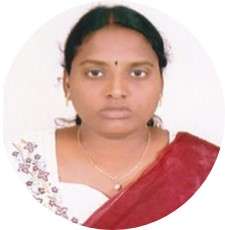 Dr. M. Jothilakshmi, Assistant Professor, VUTRC, Perambalur Tamil Nadu drjothi80@gmail.com
Dr. M. Jothilakshmi, Assistant Professor, VUTRC, Perambalur Tamil Nadu drjothi80@gmail.com
 Dr. K. Senthilkumar, Assistant Professor, VCERI, Namakkal, Tamil Nadu
Dr. K. Senthilkumar, Assistant Professor, VCERI, Namakkal, Tamil Nadu
 Dr. K. Satheeskumar, SRF, NICRA scheme (2016-2019) ksathis28@gmail.com
Dr. K. Satheeskumar, SRF, NICRA scheme (2016-2019) ksathis28@gmail.com
 Mr. R. Prabaharan, Field Assistant, NICRA scheme (2016-2019). Prabhakaranrps1994@gmail.com
Mr. R. Prabaharan, Field Assistant, NICRA scheme (2016-2019). Prabhakaranrps1994@gmail.com
 Mr. K. Jayakumar, Young Professional II, NICRA scheme (2019-2020) jaipragath@gmail.com
Mr. K. Jayakumar, Young Professional II, NICRA scheme (2019-2020) jaipragath@gmail.com

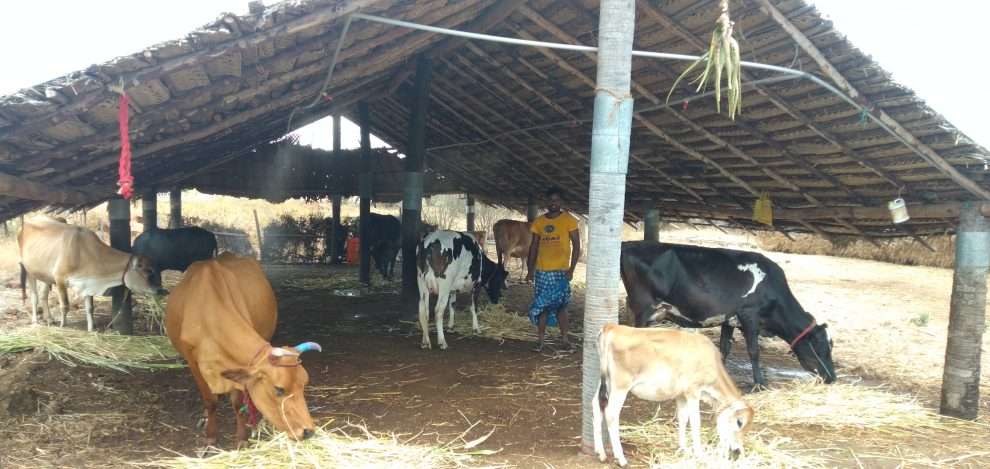

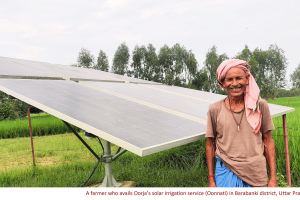
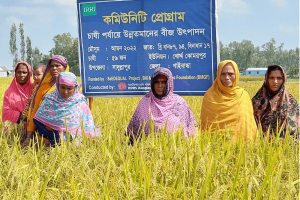
Add Comment